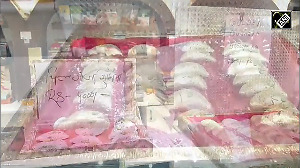 When Indian Hotels Chairman Ratan Tata told shareholders at the annual general meeting earlier this week that the hotel chain, which operates the Taj group, continues to be impacted by the slowdown, he was merely echoing what P R S Oberoi, his counterpart at the East India Hotels (EIH), had said recently.
When Indian Hotels Chairman Ratan Tata told shareholders at the annual general meeting earlier this week that the hotel chain, which operates the Taj group, continues to be impacted by the slowdown, he was merely echoing what P R S Oberoi, his counterpart at the East India Hotels (EIH), had said recently.
Oberoi said 2008-09 had been one of the most challenging in the company's 59-year history, and EIH, which runs the Oberoi group, will continue to face a challenging environment this year.
The performance of these two leading chains bear this out. In the first quarter of the year, EIH saw a 22 per cent dip in its net profit. The impact was much more severe for Indian Hotels, which posted a 73 per cent decline in net profit during the quarter, while total income was down 24 per cent, partly on account of closure of 287 rooms in the Taj Mahal Palace and Tower in Mumbai, target of a terrorist attack last year.
Room rates have also seen a sharp decline during the quarter, as the effort was on to fill empty rooms. The industry faces a double whammy -- declining demand and increasing supply. This year is particularly challenging, as a bunching of supply is projected.
In the premium 5-star segment, for instance, rating agency Crisil had earlier estimated that about 3,000 rooms will be added in the current year in the 12 destinations it tracks, compared with about 1,000 rooms last year.
"There has been a sharp 25-35 per cent decline in tariffs of the deluxe upmarket hotels and a more moderate 10-20 per cent dip in the mid-market segment," said Manav Thadani, the managing director of hotel research and consulting firm, HVS International, which tracks the 300-odd branded hotels in the country.
While the dip in rates had been a muted 2 per cent in the past year (compared to the year before), HVS expects a countrywide decline of 20 per cent in room rates this year.
Occupancy is likely to remain at around 60 per cent, the same as last year, though sharply lower than the 69 per cent occupancy recorded in the year before (2007-08).
"I can assure you that there will no rate increases this year. . . except perhaps for a one-odd. I do not expect any city to see a rate increase," asserted Thadani, while shrugging off talk of rate increases as mere bravado.
This is despite the fact that at least one premium hotel chain -- The Lalit -- has gone ahead and decided on a rate hike in October.
"We will certainly see some hikes in tariffs, about 10 per cent, in our properties in Delhi, Mumbai and Bangalore," said Shobu Mathew, vice president of sales at Bharat Hotels, which runs The Lalit group of hotels.
But most feel that's more an exception rather than the rule. "The fundamentals continue to remain weak," said Sridhar Chandrasekhar, head of research at Crisil. "Our information is that rates are falling further," he added.
According to Crisil data, average room rates have dropped 26 per cent in the first quarter of the year. The overall drop this year was likely to be above 20 per cent, though the final numbers were yet to be crunched, Crisil analyst Sudip Mukherjee said.
But, hotels are under pressure to increase rates, given the increasing costs of staff and other inputs like energy.
"Costs would go up by 5-7 per cent. Therefore, to keep the same profitability, average realisation would have to go up. That can obviously be done only if the market can sustain it," said Vivek Nair, vice chairman and managing director at Hotel Leelaventure.
Whiff of a revival
| PREMIUM HOTELS' PERFORMANCE | |||
| City | RevPAR* (Rs) | Change (%) | |
| June 2009 |
June 2008 | ||
| Bengaluru | 6,076 | 10,046 | (-)40 |
| North Mumbai | 4,827 | 7,534 | (-)36 |
| Delhi | 4,501 | 6,144 | (-)27 |
| South Mumbai | 4,404 | 6,771 | (-)35 |
| Chennai | 3,622 | 5,354 | (-)32 |
| Kolkata | 3,581 | 4,898 | (-)27 |
| Goa | 3,069 | 3,048 | 1 |
| Hyderabad | 2,938 | 4,653 | (-)37 |
| Ahmedabad | 2,767 | 3,687 | (-)25 |
| Pune | 2,754 | 5,388 | (-)49 |
| Agra | 1,833 | 1,874 | (-)2 |
| Jaipur | 1,572 | 1,391 | 13 |
| *RevPAR is the total room revenue divided by the number of rooms available, while the more commonly used average room rate is the total room revenue divided by the number of rooms sold Source: Crisil Review - June 2009 | |||
In the first three months of 2009, tourist arrivals declined by 10-18 per cent, compared with the same period last year, according to provisional data compiled by the tourism ministry. Then, things improved; the decline in April and May came down to single digits --- 3.5 per cent and 1.9 per cent -- and in June, arrivals were up 0.3 per cent.
Foreign tourist arrivals in June were at 341,000 against 340,000 last year So, the trend is positive.
"Things are much better today than they were two months ago," conceded a senior official of a large premium hotel chain who did not want to be quoted. The official said there has been an upward trend in occupancy and rates in the past few weeks.
Data from Crisil (see chart) show some relief in room rates in the tourist destinations of Goa and Jaipur. These are also the only two destinations showing an increase in occupancy.
Occupancy in Goa went up to 61 per cent in June 2009, compared with 56 per cent in the same month last year. In Jaipur, occupancy went up to 37 per cent against 35 per cent in June last year.
The interesting point is, while occupancy rates across all leisure destinations rose, business destinations, widely regarded as the cash cows for the industry, witnessed a substantial decline. That's giving sleepless nights to the leading lights of India's hospitality industry.







 © 2025
© 2025